The following dictionary is devoted to Georgian cuisine. Known for its rich flavors, diverse ingredients, and unique culinary techniques, Georgian food becomes a favorite of nearly all who try it. It is also surprisingly healthy and, overall, vegetarian-friendly. Our curated entries below outline not only well-known favorites like khachapuri, but also lesser-known desserts, a selection of wines, and descriptions of some of the major seasonings that make Georgian cuisine so distinct.
Note that the Georgian language does not use the Latin alphabet and there are sometimes different ways of spelling and rendering the names of Georgian foods. We have preferred here using names that most match the original language, but also provide an “a.k.a.” section with other spellings and names, including Anglified and Russified versions that people may be more familiar with.
From the sun-drenched vineyards that birth world-renowned wines to the bustling markets spilling over with fresh herbs and spices, Georgian cooking is a testament to the country’s love for feasting and hospitality. Join us as we traverse this flavorful landscape, one dish, and one word at a time.
Acharuli Khachapuri: (Bread) Boat-shaped bread filled with cheese and topped with butter and a sunny-side-up egg. This dish hails from Adjara, a semi-autonomous region region within Georgia. For more specifically on this region’s unique cuisine, see our Guide to Food in Adjara. (a.k.a. Adjaruli khachapuri, Adjarian khachapuri, Khachapuri po-Adjarskii)
Adjika: (Condiment) A flavorful sauce made from peppers, garlic, herbs, and spices. Commonly used as a condiment or marinade for meats and vegetables. This can range in spiciness from something close to ketchup to a fiery paste.
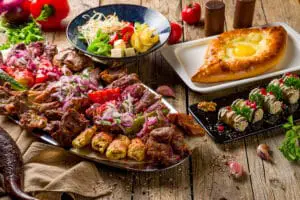
Ajapsandali: (Stew) A vegetable stew made with eggplant, bell peppers, tomatoes, onions, garlic, and a variety of herbs and spices. It can be served hot or cold. (a.k.a. Adjapsandal)
Badrijani Nigvzit: (Appetizer) Fried eggplant slices filled with a walnut paste and flavored with garlic, vinegar, and spices. (a.k.a. Georgian eggplant rolls)
Bay Leaf: (Seasoning) Used to infuse soups, stews, and meat dishes with its aromatic flavor.
Blue Fenugreek: (Seasoning) Less bitter than regular fenugreek, with a slightly nutty taste, key in khmeli suneli.
Borjomi: (Beverage) Borjomi Mineral Water is a naturally carbonated mineral water sourced from the Borjomi Gorge in Georgia. It is known for its unique taste and reputed health benefits due to its high mineral content, including calcium, magnesium, and bicarbonates.
Chacha: (Spirit) Chacha is a strong spirit made from grape pomace, which is the leftover skins, pulp, seeds, and stems from winemaking. It is similar to Italian grappa or French marc. Chacha has a high alcohol content, typically around 40-65% ABV, and is enjoyed as a digestive or used in cocktails.
Chakapuli: (Stew) Traditional Georgian stew made with by slow cooking lamb or veal in white wine, tkemali, tarragon, green onions, and other herbs. This dish is particularly associated with spring – when tkhemali is usually made for the year.
Chanakhi: (Stew) Hearty stew made by layering lamb or beef, potatoes, tomatoes, eggplant, onions, and peppers, with various herbs and spices and then slow cooking it, often in individual clay pots.
Chashushuli: (Stew) Spicy beef stew with tomatoes, onions, peppers, and a blend of aromatic herbs and spices.
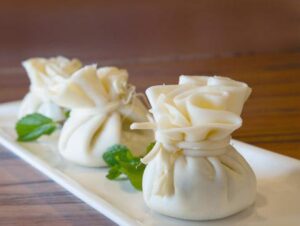
Chechil: (Dairy Product) A Georgian string cheese made from cow’s milk, stretched and twisted into long strands. It has a salty and tangy flavor, with a chewy texture. Chechil cheese is often eaten as a snack or used as a topping for salads and other dishes. It is often served smoked and goes well with beer.
Chirbuli: (Main Dish) A traditional Georgian breakfast dish originating from the Adjara region, Chirbuli combines lightly poached eggs with a tomato and walnut sauce, often infused with garlic, onions, and a variety of Georgian spices such as coriander and fenugreek. This hearty and flavorful dish is typically served with fresh bread.
Cheese: Georgia is a mountainous country that produces many dairy products – mostly from cow and sheep milk. Cheese is part of many meals eaten at home and is stocked in cornucopic abundance in the local marketplaces. There are many types of cheese and regional specialty cheeses to try ranging from moldy dambalkhacho to semi-soft sulguni to creamy nadugi.
Chicken Tabaka: (Main Dish) Cornish hen flattened and fried in a pan with garlic, herbs, and spices until crispy. (a.k.a. Georgian Fried Chicken)
Churchkhela: (Dessert) Candle-shaped candy made by dipping strings of nuts (usually walnuts or hazelnuts) in concentrated juice (usually grape), then drying them. This dessert was designed to travel well and can make for an excellent souvenir to take home and share with friends.
Cilantro: (Seasoning) From the same plant as coriander, these leafy greens are used for distinct, citrusy flavor.
Coriander: (Seasoning) from the same plant as cilantro, these dried seeds are used for their citrusy flavor.
Dill: (Seasoning) Fresh and dried dill are used extensively for their grassy and slightly sweet flavor.
Garlic: (Seasoning) A staple in Georgian cuisine, used generously for its pungent flavor.

Gomi: (Porridge) This traditional Georgian dish made from cornmeal and water and typically mixed with butter and cheese giving it a thick, gooey texture. It can be eaten as a breakfast by itself or as a side dish alongside meats and stews.
Guda Cheese: (Dairy Product) Guda cheese (not to be confused with gouda) is a traditional Georgian sheep’s milk cheese that is aged in sheepskin bags, giving it a particularly bold taste. It is native to the Tusheti region in eastern Georgia.
Guruli Khachapuri: (Bread) This versian of khachapuri is rolled and folded like a calzone and stuffed with cheese and chopped hard-boiled eggs. It hails from the Georgian region of Guria. (a.k.a. Gurian khachapuri; Khachapuri po-guriiski)
Imeruli Cheese: (Dairy Product) A traditional Georgian cheese originating from the Imereti region, made from cow’s milk. It has a slightly salty and tangy flavor, with a semi-soft texture. Imeretian cheese is often used in various Georgian dishes, including khachapuri and salads.
Imeruli Khachapuri: (Bread) A type of khachapuri originating from the Imereti region of Georgia, characterized by its round shape and cheese-filled center. The cheese used is typically salty and tangy, such as Imeretian or Sulguni cheese. (a.k.a. Imeretian khachapuri; Khachapuri po-Imeretinskii)
Khachapuri: (Bread) Cheese-filled bread that comes in various regional varieties, with the most well-known being such as Imeruli, Acharuli, and Megruli.
Khinkali: (Appetizer) Dumplings filled with spiced meat (usually beef or pork), herbs, and onions. They are made with a thick handle on top and are meant to be eaten by hand.

Kharcho: (Stew) A rich and hearty soup made with beef or chicken, walnuts, rice, tomatoes, and a blend of aromatic spices. (a.k.a. Georgian beef stew)
Khmeli Suneli: (Seasoning Blend) Traditional Georgian spice blend made from a mixture of herbs and spices such as coriander, fenugreek, marigold, and others, often used to flavor meats and stews.
Khvanchkara: (Beverage; Wine) Khvanchkara is a semi-sweet red wine made from a blend of Alexandrouli and Mujuretuli grapes grown in the Racha region of Georgia. It has a vibrant ruby color and a luscious, fruity flavor profile with notes of ripe cherries, berries, and a subtle sweetness balanced by refreshing acidity.
Kindzmarauli: (Beverage; Wine) Kindzmarauli is a semi-sweet red wine produced from Saperavi grapes, primarily in the Kvareli region of Kakheti. It has a deep red color and a velvety texture, with flavors of ripe red fruits such as cherry, raspberry, and plum, complemented by hints of spice and a gentle sweetness.
Kisi Wine: (Beverage) An aromatic white wine from Georgia, kisi wine is produced from the kisi grape, a variety recently saved from near-extinction and highly prized for its complex array of flavors from lush fruit to floral and spicy undertones, with a notable structure and balanced acidity. Kisi can be made in various styles, from dry to semi-sweet, showcasing the versatility of the grape.
Kubdari: (Bread) A bread filled with spiced meat mixture, typical of the Svaneti region.
Lavash: (Bread) Thin, soft flatbread, often served alongside main dishes, as an accompaniment to many appetizers, or used to wrap meats and vegetables.
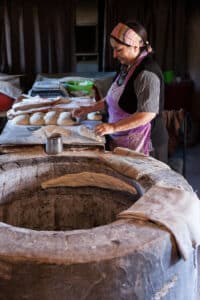
Lobiani: (Bread) Georgian bread stuffed with a lobio, a spiced bean stew. (a.k.a. Georgian Bean Bread)
Lobio: (Stew) Traditional Georgian dish made with kidney beans, onions, garlic, and a blend of spices. This can be eaten on its own or as an accompaniment to bread.
Marigold Petals (Tagetes): (Seasoning) Impart a rich, slightly bitter flavor and a golden color to dishes.
Matsoni: (Dairy Product) Matsoni is a traditional Georgian fermented milk product similar to yogurt or kefir. Creamy and tangy, it can be served as a beverage, dessert, or snack, sometimes sweetened with honey, fruit, and/or nuts and is also used as an ingredient in various Georgian dishes.
Mchadi: (Bread) Cornbread typically made from cornmeal, water, and salt, cooked on a griddle until crispy. (a.k.a. Georgian cornbread)
Megruli Khachapuri: (Bread) A variation of khachapuri originating from the Samegrelo region of Georgia, distinguished by its additional layer of cheese over the top of the bread, baked until golden brown. (a.k.a. Mingrelian khachapuri; Khachapuri po-Mingrelskii)
Mint: (Seasoning) Adds a refreshing note to salads, meat dishes, and sauces. Used both fresh and dried.
Mtsvadi: (Main Dish) Georgian kebabs, made with marinated chunks of meat (such as pork, beef, or lamb) or vegetables grilled on skewers. (a.k.a. shashlyk; kebabs)
Nadugi: (Dairy Product) This tangy farmer’s cheese is often used as a spread or dip and can also be incorporated into sauces and dressings.
Natakhtari Soda: (Beverage) A popular Georgian carbonated soft drink brand that comes in a variety of traditional local flavors, including including tarragon, pear, barberry, and cream. This serves as a perfect non-alcoholic accompaniment to the rich and hearty dishes of Georgian cuisine, offering a palate-cleansing effervescence and a glimpse into the country’s innovative approach to traditional flavors.
Pelamushi: (Dessert) A traditional Georgian dessert made from grape juice and corn flour, cooked until thickened and then molded into various shapes. It’s often served chilled and garnished with walnuts. (a.k.a. Georgian grape pudding)
Pkhali: (Appetizer) Dish made from finely chopped vegetables (such as spinach, beetroot, or green bean) mixed with ground walnuts, vinegar, and herbs. These can be eaten on their own but are more often served as an accompaniment to bread.
Qvevri Wine: (Beverage) An emblem of Georgian winemaking tradition, qvevri are large earthenware vessels used for fermenting, storing, and aging wine. This ancient method involves burying the qvevri underground, providing a consistent temperature during fermentation. Traditionally, qvevri wines integrate the grape’s skins, seeds, and stems, often resulting in wines with distinctive textures, deep colors, and robust flavors. Qvevri wines can be made from both white and red grape varieties, with the whites often exhibiting an amber hue due to prolonged skin contact. Celebrated for its artisanal approach and its contribution to the natural wine movement, Qvevri wine embodies the soul of Georgian winemaking, linking modern enthusiasts to millennia of tradition.
Red Pepper Flakes: (Seasoning) Adds heat and spice to dishes, including adjika sauce.
Rkatsiteli: (Beverage; Wine) Rkatsiteli is one of the oldest grape varieties in Georgia, producing white wines with crisp acidity and vibrant flavors. These grapes are primarily grown in the Kakheti region. Rkatsiteli wines are white and typically dry and refreshing, with notes of green apple, citrus, and herbs, sometimes with a hint of floral aroma.
Saffron: (Seasoning) Used sparingly for its luxurious aroma and beautiful color.
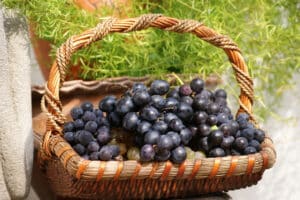
Saperavi: (Beverage; Wine) Saperavi is one of Georgia’s most famous red grape varieties, producing deeply colored wines with rich flavors. It is grown throughout Georgia, but particularly in the Kakheti region. Saperavi is a red wine that can vary from dry to semi-sweet, with bold flavors of dark berries, plums, spices, and occasionally a hint of chocolate or tobacco.
Satsivi: (Sauce) Thick, creamy sauce made from ground walnuts and spices, typically served with chicken or turkey as a cold appetizer. This dish is highly associated with holidays such as the New Year in Georgia.
Shkmeruli: (Main Dish) A traditional Georgian dish featuring chicken cooked in a garlic and milk sauce until tender and flavorful. (a.k.a. Georgian garlic chicken)
Sulguni Cheese: (Dairy Product) A popular Georgian cheese with a semi-soft texture and a tangy flavor. It is typically made from cow’s milk and is commonly used in Georgian cuisine, especially in dishes like khachapuri and mushrooms with sulguni.
Sumac: (Seasoning) Used for its tangy, lemony flavor in spice blends and as a garnish.
Svanski Sol: (Seasoning Blend) A distinctive and aromatic seasoning blend hailing from the mountainous Svaneti region, Svanski sol (Svan salt) is a robust mixture that typically includes salt, garlic, coriander, blue fenugreek, and other local herbs and spices, offering a potent and flavorful accent to that goes with almost everything from meats to vegetables and soups. A bottle of this picked up at any Georgian supermarket makes for an excellent souvenir to take back home.
Tarkhun: (Beverage) A refreshing carbonated soft drink flavored with tarragon extract, popular in Georgia and other Eastern European countries.
Tarragon: (Seasoning) Essential for making tarkhun soda and often paired with poultry, this herb is used for its unique, slightly anise- or licorice-like flavor.
Tkemali: (Sauce) Tangy, sour plum sauce commonly used as a condiment or dipping sauce for various dishes, especially meat dishes such as Mtsvadi.
Tklapi: (Dessert) A traditional Georgian fruit leather made from fruit puree that is spread thinly and dried in the sun. It can be made from various fruits, such as plums, apples, or cherries, and is typically eaten as a sweet snack.
Tolma: (Appetizer/Main Dish) Tolma is a variation of the more widely known dolma, involving grape leaves or sometimes cabbage leaves stuffed with aromatically seasoned meat and rice. It is often served with a yogurt or matsoni dipping sauce.
Tsinandali: (Wine) Tsinandali is a dry white wine made from a blend of Rkatsiteli and Mtsvane grapes, grown in the Tsinandali microzone within the Kakheti region. It has a pale straw color and a crisp, refreshing acidity, with flavors of citrus fruits, green apple, and pear, often accompanied by floral and herbal notes.
You’ll Also Love
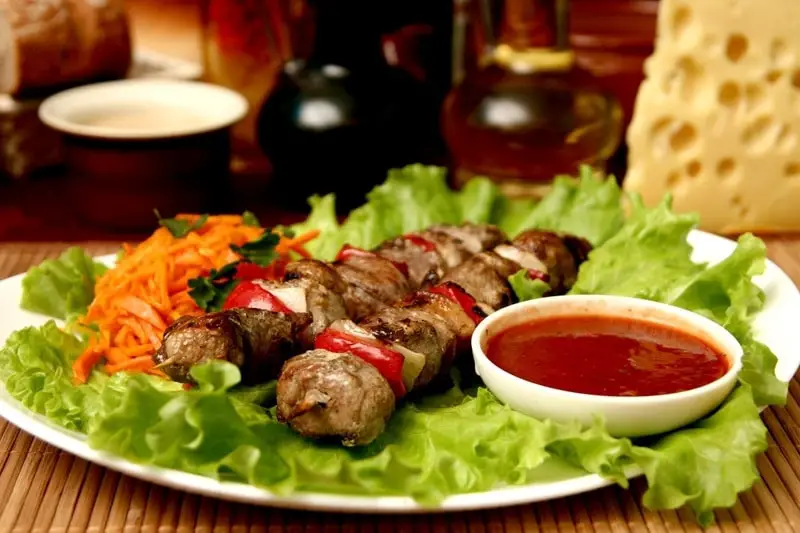
All About Shashlyk (BBQ from the Caucasus)
Shashlyk (шашлык) is considered to be one of the very first dishes humans invented and most likely hails from the place the first modern human likely appeared – the area covering Iran, Iraq, Lebanon, and the Caucasus. How “Shashlyk” Got Its Name (Почему он так называется?) The word “шашлык” was adopted into Russian in the […]

Tkemali: Georgian Sour Plum Sauce
Dr. Michael Denner (notes from the American Test Kitchen): Georgians jokingly refer to tkemali (more accurately written t’q’emali) as “Georgian ketchup.” It gets poured on practically everything. I don’t know of another sauce like it: sour, fruity, salty, with a serious herbal punch and a bit of lingering heat. Maybe it looks like Mexican salsa […]
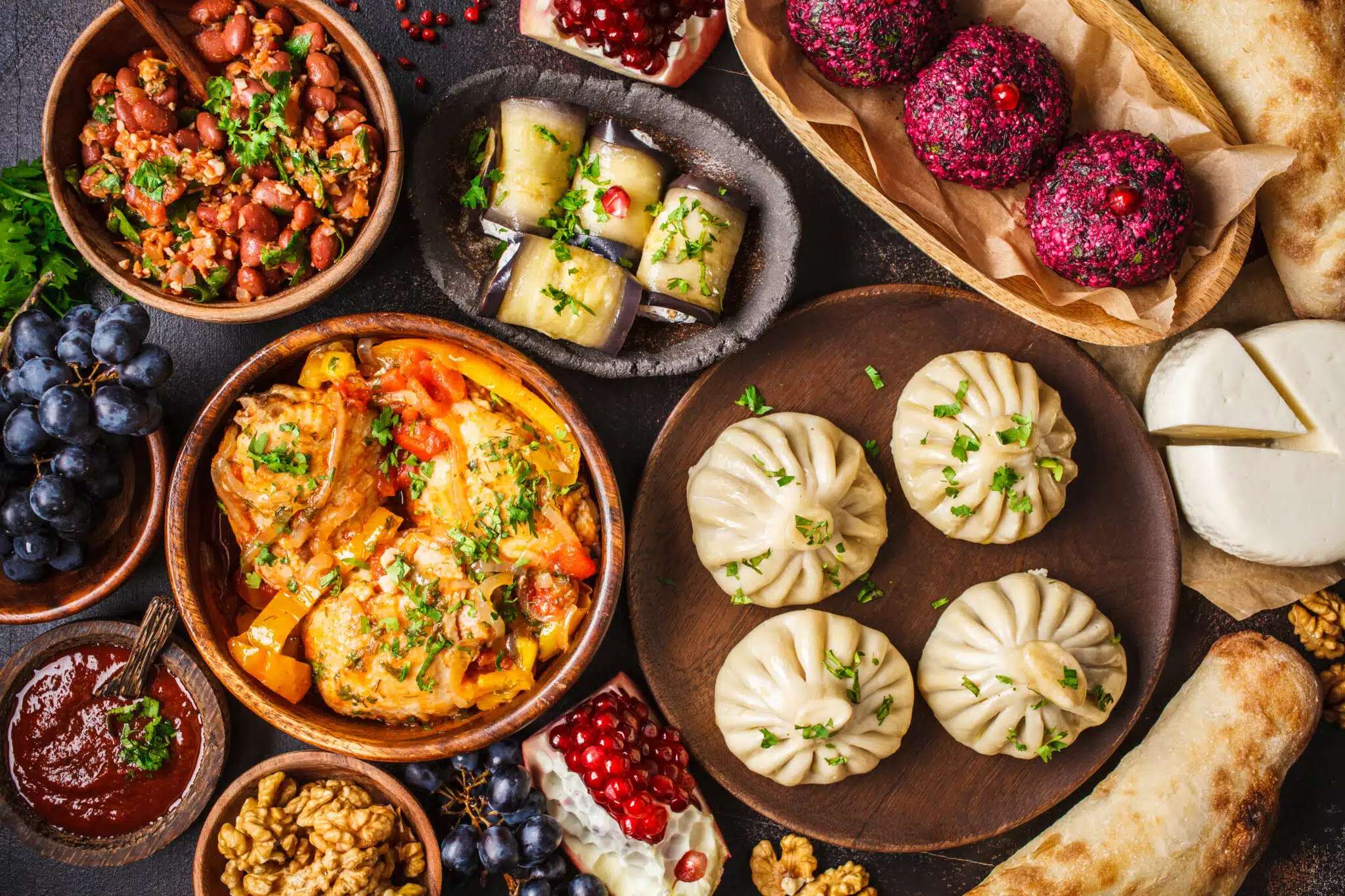
Dictionary of Georgian Food
The following dictionary is devoted to Georgian cuisine. Known for its rich flavors, diverse ingredients, and unique culinary techniques, Georgian food becomes a favorite of nearly all who try it. It is also surprisingly healthy and, overall, vegetarian-friendly. Our curated entries below outline not only well-known favorites like khachapuri, but also lesser-known desserts, a selection […]
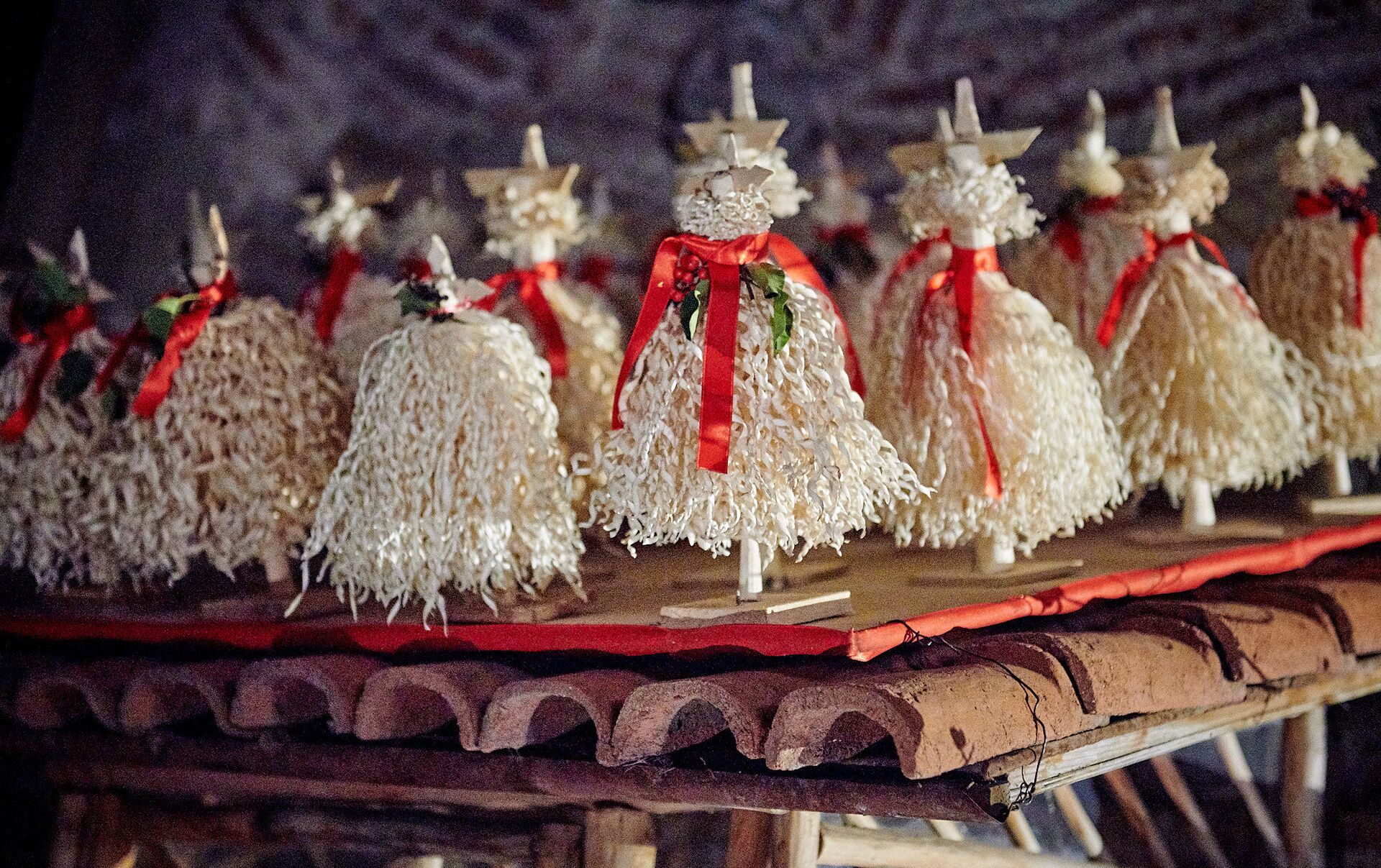
Chichilaki and Alilo: Georgia’s Unique Celebrations of Christmas
Georgia’s Christmas traditions of chichilaki and alilo reflect the deeprooted importance of tradition, sustainability, and religious expression in Georgian culture. Chichilaki are a unique, eco-friendly alternative to the Christmas tree that have been present in Georgian culture since ancient times. Meanwhile, alilo is a caroling tradition when costumed Georgian take to streets to sing religious […]
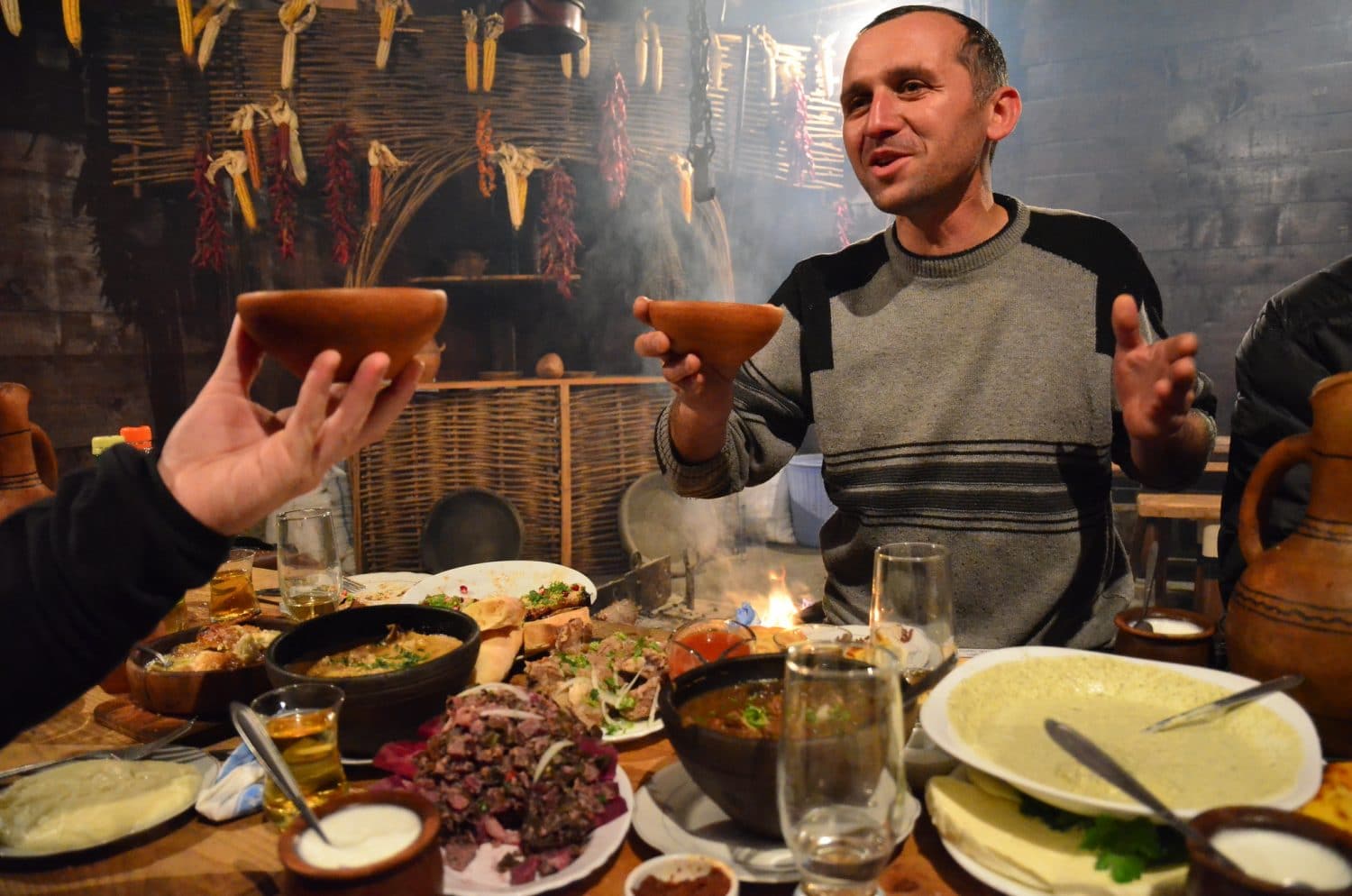
Georgian Nutrition: A Tasty Way to Good Health
As a nutritionist, food is often the driving factor of my travels. I love exploring the local and traditional cuisines which help shape the identity of a country. Georgian culture is strongly influenced by, and perhaps best known for, its unique and vibrant cuisine. Georgian cuisine in Georgia is packed with fresh and organic produce […]




